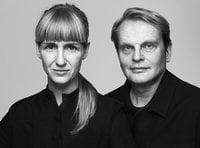Ambit Rail from Muuto is TAF Studio's fresh take on classic billiard table lamps. The minimalist design comprises a row of three simple shades, familiar from the Ambit pendant lamp, and a horizontal metal rail suspended by two steel wires. The thinness of the wires creates a fun illusion of a floating lamp, and the white interior of the spun aluminium shades reflects light in a pleasant manner. Ambit Rail makes an excellent choice above any kitchen island, dining table and meeting table.
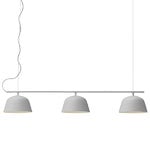
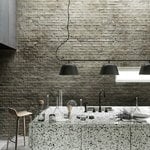
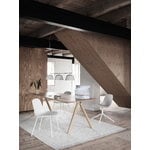
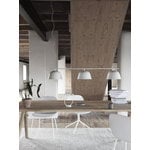
Ambit Rail lamp, grey
Muuto
Description
Ambit Rail from Muuto is TAF Studio's fresh take on classic billiard table lamps. The minimalist design comprises a row of three simple shades, familiar from the Ambit pendant lamp, and a horizontal metal rail suspended by two steel wires. The thinness of the wires creates a fun illusion of a floating lamp, and the white interior of the spun aluminium shades reflects light in a pleasant manner. Ambit Rail makes an excellent choice above any kitchen island, dining table and meeting table.
Product details (17)
- Material
- Aluminium, steel, rubber
- Colour
- Grey
- Length
- 126 cm
- Width
- 25 cm
- Height
- 20 cm
- Bulb base
- E14
- Light source
- 3 x Dimmable max 11W LED (not included), max length of bulb 85 mm
- IP rating
- 20
- Protection class
- II
- Voltage
- 220–240 V
- Nominal frequency
- 50–60 Hz
- Certifications and labels
- CE marked: tested and approved according to European standards
- Cable length
- 400 cm
- Canopy
- Yes: white; diameter: 9 cm, height: 5.6 cm
- Ceiling plug
- No
- Dimmable
- Yes
- Notes
- Wire length 3.5 m
- Product ID
Designer
The Swedish architects Gabriella Lenke and Mattias Ståhlbom have run the architecture and design studio TAF (previously TAF Architects) in Stockholm, Sweden, since 2002. TAF Studio’s aim is to make ordinary life less ordinary through subtle but effective changes in how products and architecture appear and function. A recurrent departure point in TAF Studio’s projects is that everyday objects by their very commonness can be made uncommon.
View all productsReviews (0)
Sustainability
The Product Sustainability Framework, our criteria of sustainable design, helps you find the most sustainable products in our selection. Read below which sustainability criteria this product has met.
Working conditions & labour 7/9
-
Equal opportunities for all employees
-
Commitment to UN Global Compact, fair compensation for all employees
-
Corporate responsibility requirements defined and communicated for suppliers
-
Systematic work for improved inclusion and well-being in the workplace
-
Transparent supply chain
-
Suppliers' compliance to a code of conduct ensured
-
Compliance to the UN Guiding Principles on Business and Human Rights ensured in the supply chain
-
Direct suppliers audited and certified
-
Support for community involvement in the supply chain
Eco-friendly production 9/9
-
Fair and resource-wise water-use in production
-
No incineration or landfilling of returned items
-
No use of endangered species as materials
-
No direct environmental emissions or waste (excl. GHGs) from production
-
The sustainability of direct suppliers' production is addressed and monitored
-
Production and material sourcing that respect biodiversity, animal rights, and natural ecosystems
-
Material-efficient and ecological packaging
-
Positive impact on nature’s well-being through operations that regenerate natural ecosystems
-
No potentially harmful chemicals used in own production
Climate impact 5/8
-
Company's direct greenhouse gas emissions identified and commitment to reduction
-
Product's carbon impact identified and commitment to reduction
-
Guidance on energy- and eco-efficient use of the product
-
Contribution to climate initiatives beyond the brand’s direct operations
-
Carbon footprint of the product calculated and goals set to reduce it
-
Low-carbon or compensated transportation
-
100 % renewable energy in own production and operations
-
Carbon neutral or carbon negative product
Sustainable materials 4/6
-
Sustainable and long-lasting material choices
-
No harmful or hazardous substances
-
Responsible raw material sourcing and production
-
Materials suited for circularity: monomaterials, recyclable finishings, renewable or recycled contents etc.
-
Ecological materials: natural, biodegradable, recyclable or recycled contents
-
Outstanding materials in terms of innovativeness, responsibility, sustainability and circularity: local production or sourcing, 100 % recycled content, C2C-certification etc.
Circular design 4/5
-
High aesthetic quality promoting long-term use of the product
-
Technically durable product design and material choices
-
Design for enduring life-long quality
-
Design and support for product maintenance, repair and upgradability
-
Innovative circular design solutions: circular service system, resale platform, remanufacturing, collection of used products, etc.




